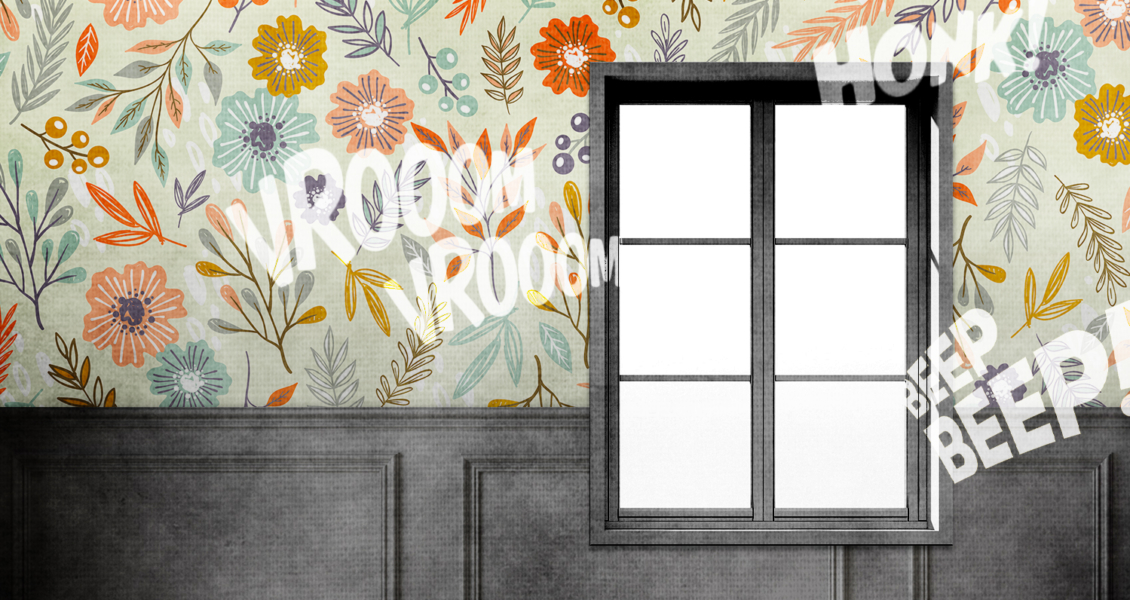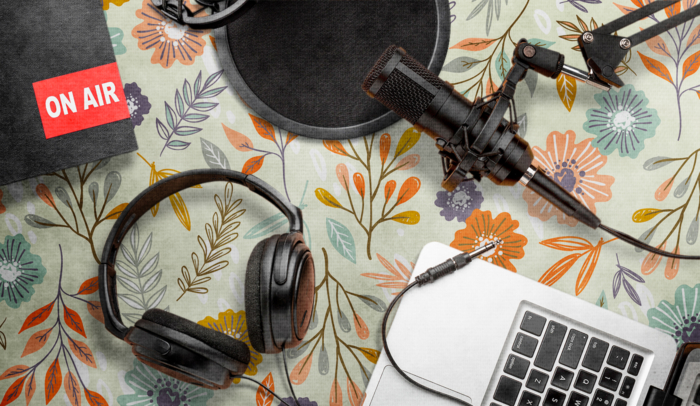Can you record your own audiobook? Definitely. This post will walk you through all the equipment you need. Just remember that the recording process is only the first step in producing a finished audiobook.
You’ll also need to:
- edit your audio files
- engineer the sound quality to minimize ambient noise and be sure not to exceed the maximum noise floor requirements (among other specs)
- upload them to an audiobook distributor
As you read through this step-by-step guide to audiobook equipment, consider the time it will take to learn how to produce a quality audiobook from start to finish.
If time is a limiting factor for you, consider all your audiobook options before you start.
1. Recording Space
If you’re going to record your audiobook yourself, you first need a quiet, dedicated recording space. But here’s the problem: what you think is quiet isn’t really quiet.

Every apartment or home is filled with background noise. We don’t hear it because we tune it out — noise from pipes, heating and air conditioning, cars outside, even the fridge’s hum. That ambient noise is always there.
Your mic will pick up that background noise, reducing the sound quality of your audio recording beyond repair. Don’t expect your recording software to edit it out.
That’s why recording studios start with soundproof rooms. All the professional studio equipment in the world won’t fix your audio files if they start with poor audio quality.
Unfortunately, a professional-grade acoustic recording environment that blocks out external noise isn’t cheap. Even an entry-level preconfigured recording box isn’t worth it if you’re only planning on recording one audiobook.
Soundproofing a small room is your best bet if you’re dead-set on creating your own recording space in your home.
2. Soundproofing
Soundproofing a room in your home or workspace requires:
- Keeping outside noises out
- Minimizing internal noise, from electrical noise to mechanical vibrations
- Minimizing echo from the sound of your voice
- Reducing the background noise of your equipment setup
Start by choosing your space. Keep it relatively small, but not so small that you can’t move. Closets can work if they aren’t next to an outside wall or a wall that contains plumbing.
Cover your space in acoustic foam tiles or other sound absorption panels. In a pinch, you can use foam panel insulation from your local home improvement store.
Just remember to include a way for most of your equipment to be outside the room. For example, the fan from your computer can ruin a recording session. You’ll need to be able to run cords through the wall or door.
3. Computer with at least 8GB of RAM
The computer you need will depend mostly on the audio recording software you’re running for the recording process.
Some pro-quality software may require more RAM than other options, so check your computer’s specifications.
Start with the personal computer you already own. It can be a Mac or a PC. Either one is fine. Don’t upgrade your computer unless it just isn’t capable of handling your audiobook production setup.
4. Digital Audio Workstation
A digital audio workstation is computer software that lets you record audio, edit sound files, and produce your finished book files.
If you’re recording your own audiobook, you’ll want a DAW that can handle every stage of the process, from recording to your finished audio production.
Audacity, Twisted Wave, Reaper, and Studio One are all good. Pro Tools is great, but it’s more than you probably need if you’re only recording audiobooks.
Whatever you choose, look into third-party plugins from companies like Waves, Izotope, FabFilter, and Slate Digital to help with compression, limiting, expanders, mouth de-click, de-essers, EQ, and more.
It’s imperative at this point that you hire an experienced audiobook engineer to help you learn how to use these plugins appropriately. If you’ll be the only one using your recording setup, you won’t need to change these settings unless you upgrade your equipment. So, once the settings are dialed in, you’re good to go!
5. Microphone
Most audiobook recordings use a Large Diaphragm Condenser mic. These mics are sensitive, so they’ll capture your voice beautifully. Unfortunately, they capture everything else too. A condenser is great for a quiet voice because you won’t need as much input gain.
Dynamic mics aren’t quite as sensitive. If you speak with a lot of mouth noise, a dynamic mic could be a good option. It won’t pick up as much noise, but you’ll need to crank up the input gain. Consider an inline preamp like a Cloudlifter or Dynamite to provide more than 20dB of clean gain before the signal hits your preamp.
6. Pop Filter
Plosives are blasts of air that hit the mic and produce a popping sound. These usually happen on words that start with p, but they can also result from t, k, and b sounds.
A pop filter breaks up those blasts of air, so they don’t produce those pops, giving you one less thing that needs your attention during editing. If you’re still getting plosives with a pop filter setup, you’ll need to readjust the mic and pop filter positions.
7. Shock Mount
A shock mount is a mount for your microphone that isolates your sensitive microphone from its physical environment. It keeps mechanical vibrations from interfering with your recording quality and should come packaged with any mic you buy.
If your mic is standing on a table, vibrations can transfer from the table to your mic. If your sleeve is brushing that table, or your elbows are resting on it and shifting back and forth, you probably won’t realize it until you play back your recorded files.
A shock mount can help reduce the vibrations that get into your recording.
8. Mic Boom Arm
A mic boom arm lets you move your mic into a comfortable position without changing the mount. It works with your shock mount to minimize vibrations while providing some range of movement for your microphone.
Mic boom arms vary by size, length, and how much weight they can support, so the right one will depend on your setup. It’s okay to spend extra money to ensure you have something sturdy and won’t tip over with the weight of your microphone.
9. XLR Cables
An XLR connector is a standard cable connection used for professional-grade audio equipment. Whether you need an XLR cable technically depends on the mic you choose. That said, you’ll want a pro-quality mic, and USB microphones aren’t there yet.
For a great mic with an XLR connection, you’ll need an XLR cable to connect it to a digital audio interface.
10. Digital Audio Interface
A digital audio interface connects your microphone to your computer. It converts the analog signal from the mic into a digital signal your computer can work with. Make sure your interface has high-quality preamps and analog to digital (AD) converters.
11. Headphones
Technically, headphones are optional for the audiobook recording process, but they can save you a lot of trouble. Headphones let you hear any noise your mic is picking up so you can adjust your setup before you’ve wasted a 3–6 hour recording session.
If you’re using a digital interface, plug your headphones into that. Otherwise, plug them into your computer.
Either way, you’ll want headphones for the editing process so you can hear the true playback quality of your sound engineering.
12. Reading Device
Finally, you’ll need an e-reader like a Kindle or iPad to avoid the sound of turning pages while you read. An e-reader also makes it easy to prepare your manuscript for audiobook narration, letting you take notes and highlight any sections you want to emphasize in the narration process.
Alternatives to Buying Audiobook Recording Equipment
Here’s the reality: audiobook recording isn’t cheap — what doesn’t cost you in terms of money will cost you hours and hours of time.
If you do your homework and choose the cheapest options when it comes to equipment, you’ll still have to learn how to use it. And you’ll have to soundproof part of your home. That’s a lot of work.
Is it worth it? That depends. If you want to become a professional audiobook narrator, then maybe. At least there’s a chance of a reasonable return on your investment.
But suppose you just want to create one professional quality audiobook. In that case, you’re better off hiring a united team of voice actors, audiobook producers, audio engineers, and more who can take care of your entire audiobook from production to distribution.
Think of it this way — the first time you do anything, that’s the one you learn on. It’s the one where you make mistakes and figure out how not to do things.
If you’re only creating one audiobook, you’ll spend all that time learning just to end up with an audiobook you want to toss out so you can start again. Be prepared to do that. It’s part of the learning process.
If that doesn’t sound like fun, explore our Audiobook Services to give your book a voice without the time and hassle of DIY production.


